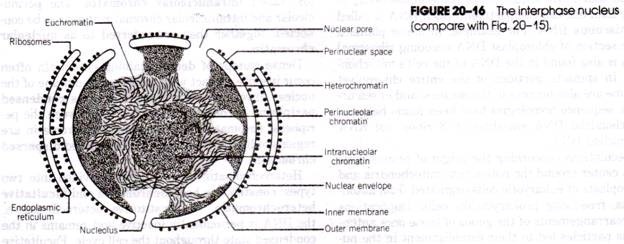The ultra-structural detail of a typical cyanobacterial cell (Fig. 6.10) is the following:
1. Mucilage Sheath:
The cells and filaments of most cyanobacteria are generally surrounded by a mucilaginous sheath whose thickness, pigmentation, consistency, and nature is greatly influenced by environmental factors. It is considered that these microorganisms secrete the mucilage through pores present in their cell walls.
2. Cell Wall:
The cell wall lies between the plasma membrane and the mucilage sheath. Like bacteria, peptidoglycan is the main consituent of the cyanobacterial cell wall. Ultra structurally, the wall consists of four layers (LI, LII, LIII, LIV) each of which is connected with the other one by a connection known as plasmodesma (pl. plasmodesmata). All cyanobacterial cell walls, like that of other prokaryotes, possess diaminopimelic acid.
3. Plasma Membrane:
A typical cyanobacterial plasma membrane is 70Å thick. It is selectively permeable, lacks sterole such as cholesterol, and consists of a high proportion of protein to phospholipid (typically 2:1) like other prokaryotes.
It generally fuses with the photosynthetic lamellae and gives rise to inward folding’s in the cytoplasm; the folding’s are called lamellosomes or mesosomes (Fig. 6.10). The latter are mostly similar in functions to mesosomes occurring in other prokaryotes.
4. The Cytoplasm:
The cytoplasm of cyanobacterial cell, like that of bacteria, is incredibly boring. It lacks eukaryotic organells such as chloroplasts, mitochondria, endoplasmic reticulum, Golgi bodies. But, it possesses photosynthetic apparatus, ribosomes, and a large number of subcellular inclusions such as glycogen or α-granules, polyphosphate bodies, polyhedral bodies, cyanophycin granules, and the genetic material.
(i) Photosynthetic apparatus:
In place of the chloroplasts of photosynthetic eukaryotes, cyanobacteria have flattened vesicular structures called thyllakoids or lamellae, which resemble the individual thyllakoids of the true chloroplasts of photosynthetic eukaryotes.
The lamellae or thyllakoids are both physiologically or structurally complex and possess photosynthetic pigments. As described earlier, the principal pigment of all cyanobacteria is chlorophyll a.
In addition, there are β-carotene and other accessory pigments, namely, phyeobiliproteins. The phycobiliproteins are phycocyanin (PC), allophycocyanin (AP), allophycocyanin-B (APB), and phycoerythrin. By possessing phycocyanin and phycoerythrin accessory pigments, the cyanobacteria resemble with red algae.
However, the necessary pigments of these organisms are generally organized into organelles called phycobilisomes and trap light energy of lower wavelengths, which cannot be absorbed by chlorophyll a, and pass it on to the chlorophyll a (Fig. 6.11).
This is the reason why cyanobacteria, like green algae, can exploit deeper waters where the quality and quantity of illumination is inappropriate for the photosynthetic plants.
(ii) Ribosomes:
These are the sites of protein synthesis. Cyanobacterian ribosomes occur freely in the cytoplasm and are identical to those of bacteria in being 70S ribosomes.
(iii) Glycogen or α-granules:
Glycogen or α-granules are the sites for storage of excess photosynthetic products. The latter is used as energy source in darkness or when CO2 supply is limiting.
(iv) Polyphosphate bodies:
These are the spherical structures formed as a result of the aggregation of high molecular weight linear polyphosphates. These subcellular inclusions are also called metachromatin granules or volutin granules and serve as phosphate stores and are consumed during periods of phosphate starvation. These structures develop mostly in those cyanobacteria that grow in a phosphate-rich environment.
(v) Polyhedral bodies:
All cyanobacteria store their ribulose 1, 5-bisphosphate carboxylase (RUBP carboxylase) enzyme in structures referred to as polyhedral bodies.
(vi) Cyanophycin granules:
Cyanobacteria growing in nitrogen-rich environment produce structures, called cyanophycin granules, which are made up of arginine and aspartic acid.
(vii) Genetic material:
The genetic material of cyanobacteria is made up of naked DNA fibrils found dispersed in the central region of the cytoplasm. Like other prokaryotes, they lack membrane-bound organized nucleus.
The exact number of genomes per cell is not yet known; it has recently been reported that Agmenellum contains 2, 3 or more copies of its genetic material. The molecular weight of the cyanobacterial genome is considered to range from 2.7 to 7.5 x 109 daltons.
(viii) Plasmids:
All the naturally occurring plasmids in cyanobacteria are phenotypically cryptic. They are covalently closed circular DNAs and their genetic compositions and complete function is not yet known. However, plasmid-mediated transfer of genetic material has been reported in certain cyanobacteria.

